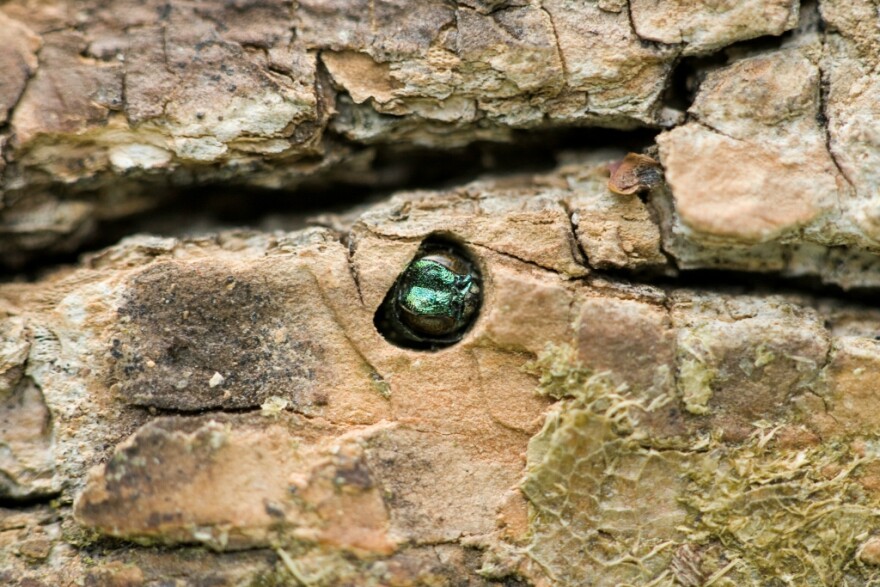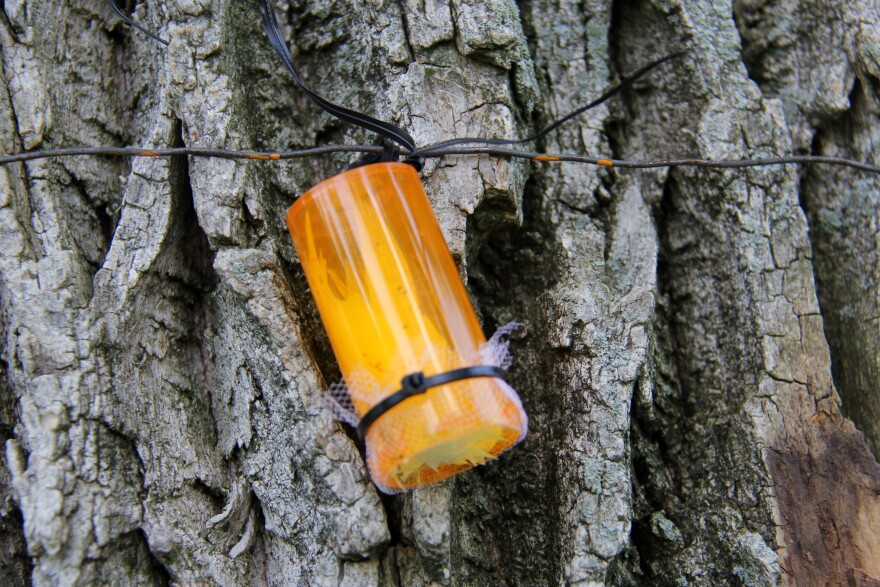On a residential street in the Central West End neighborhood, a worker wearing a hard hat and a safety vest used a chainsaw to cut the branches off of an ash tree. The tree and the ones next to it were marked for removal because the emerald ash borer, an invasive species, has come to St. Louis.
The Asian beetle has decimated ash trees across the country since the early 2000s, particularly in the Midwest and the Northeast. In recent years, the emerald ash borer has spread to 28 counties in Missouri, most recently to Franklin County.
Local authorities first detected the pest in the St. Louis in April 2015, in north St. Louis. This summer, the city’s forestry division began unrolling its $2.5 million strategy to combat the pest over five years.
Nearly one out of five trees along city streets are ash trees, making it the most common tree species in the city. The city’s plan involves cutting down about 13,000 ash trees on public property.

“It’s not something we ask for and want to do,” said Skip Kincaid, the city’s forestry commissioner. “It’s something we have to do to protect people so we don’t have dead trees all over the streets.”
Kincaid said the change to some neighborhoods will be dramatic, but streets will be in worse shape if nothing is done.
Once emerald ash borers have taken over an ash tree, the tree will certainly die within three years. An adult borer will lay eggs on the bark, which will hatch larvae. The larvae burrow into the tree and feast on the tissues necessary to transport water and nutrients to branches and leaves.
“That whole system of pipes pulling up nutrients into the tree, that whole vascular system is interrupted, so the tree begins to dry up and die,” Kincaid said. “The [trees] actually become very brittle and dangerous.”
However, the city will use chemical treatments to try save about 1,000 of its healthiest ash trees.
But for that to work, crews must treat a tree before an emerald ash borer infests it.

The effort recently got underway in north St. Louis, where a forester drilled small holes near the base of an ash tree.
He drilled that low to reach the tree’s xylem — a system of tissues that push nutrients into the rest of the tree. Then, he injected crayon-shaped tubes containing an organic insecticide into the holes.
“It’s like getting a shot in the arm or getting hooked up to an IV,” Kincaid said.
The emerald ash borer will forge a D-shaped hole in a tree. But often, it’s difficult to see such holes since they are made toward the top of the tree. Kincaid said looking at the canopy helps determine how healthy a tree is. If 30 percent of the canopy or more is dead, the tree can’t be helped, he said.
Officials also have performed cost analyses on city trees to justify the funds spent on treating them. That can be about $80 per tree, depending on its size.

“We know a tree this size is probably producing $90 to $100 a year in benefits,” Kincaid said. “So the injection becomes, just from a purely economic sense, a good investment.’
The treatments have to be given every two years.
While the city implement its plan on its own trees, there are many more ash trees in St. Louis that exist on private property.
The Bellefontaine Cemetery along the city’s northern border has taken steps against the emerald ash borer for the past four years. Kyle Cheesborough, the cemetery’s horticulture supervisor, said that it’s very likely the beetle has been in the area for several years once it’s been found.
“We hadn’t identified it officially by then, but it was just a few counties away, so we knew it was coming,” Cheesborough said. “But even when we started treating [the trees], we could have already had them.”

Like the city, the Bellefontaine Cemetery has removed ash trees and injected some with pesticides.
As a further preventative measure, the cemetery also conducts releases of parasitic wasps, which can destroy emerald ash borer eggs before they hatch.
“The parasite actually lives out its entire life cycle inside the little tiny egg and then it emerges, also killing the egg,” Cheesborough said.
The wasps, provided by the Missouri Department of Agriculture, are placed in orange pill cases that are strung around the lower part of the tree and hung from the canopy.
Cheesborough’s job requires him to be knowledgeable about how to take care of the trees in the cemetery. It bothers him that public awareness about the emerald ash borer is so low.
“One of the things that frustrates me is that no one’s really doing a very good job of educating the homeowner. And, unfortunately, homeowners retain a large population of ash trees,” he said.
In the Compton Heights neighborhood, where there is a large concentration of ash trees, resident Ron Chunn dreads the idea of seeing them disappear.

“On this street, there’s 52 ash trees and some are over a hundred years old,” Chunn said.
Chunn has five massive ash trees on his property.
“If they’re all gone, we don’t have the same property,” he said.
Chunn began having his trees treated about two years ago. His arborist, Tom Beshoar of Davey Tree Service, urged him to take action because of the emerald ash borer.
“I came to him and said, look we've got to treat these trees,” Beshoar said. “If we don’t treat these trees, they will eventually die.”
The work was expensive, but Chunn decided it was worth the investment. However, he wishes that more of his neighbors were aware of the invasive beetle.
The city’s plan is to replace ash trees in six wards by next spring. The forestry division will pick from a list of 40 species and none of them will include ash trees.

Follow Eli Chen on Twitter: @StoriesByEli





